 Famiglia de' Medici was a political dynasty, banking family and later royal house that first began to gather prominence under Cosimo de' Medici
Famiglia de' Medici was a political dynasty, banking family and later royal house that first began to gather prominence under Cosimo de' Medici in the Republic of Florence
in the Republic of Florence during the late 14th century. The family originated in the Mugello region
during the late 14th century. The family originated in the Mugello region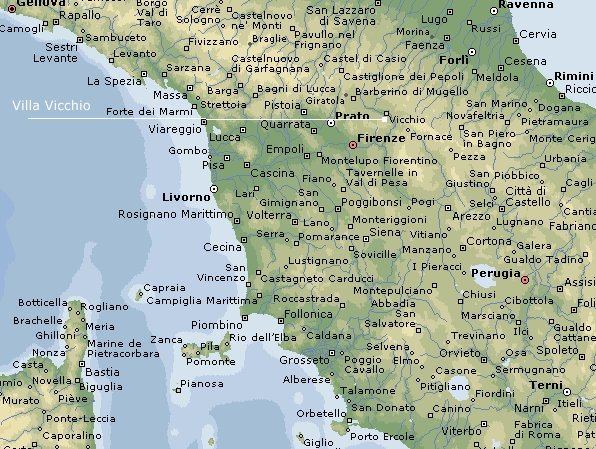 of the Tuscan countryside, gradually rising until they were able to found theMedici Bank. The bank was the largest in Europe during the 15th century,
of the Tuscan countryside, gradually rising until they were able to found theMedici Bank. The bank was the largest in Europe during the 15th century,  unable to repay the loans (the best he could do in way of repayment was to lift all tariffs on the Medici exporting English wool until such time as the debt was repaid), and the branch had loaned far too much to the Lancastrian rebels (and not
unable to repay the loans (the best he could do in way of repayment was to lift all tariffs on the Medici exporting English wool until such time as the debt was repaid), and the branch had loaned far too much to the Lancastrian rebels (and not to a number of Yorkist loyalists), who would never repay their loans after their deaths and defeats. The London branch finished its liquidation in 1478, with total losses of 51,533 gold florins.The succeeding Tudors never paid off the outstanding Plantagenet debt.
to a number of Yorkist loyalists), who would never repay their loans after their deaths and defeats. The London branch finished its liquidation in 1478, with total losses of 51,533 gold florins.The succeeding Tudors never paid off the outstanding Plantagenet debt.
The Medici produced four Popes of the Catholic Church—Pope Leo X (1513–1521), Pope Clement VII (1523–1534), Pope Pius IV (1559–1565), and Pope Leo XI
(1559–1565), and Pope Leo XI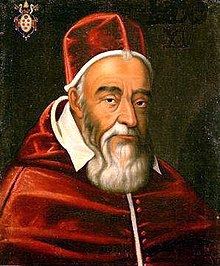 (1605); two regent queens of France—Catherine de' Medici
(1605); two regent queens of France—Catherine de' Medici  (1547–1559) and Marie de' Medici(1600–1610)
(1547–1559) and Marie de' Medici(1600–1610)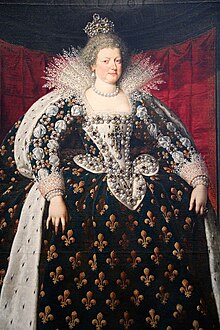 ; and, in 1531, the family became hereditary Dukes of Florence. In 1569, the duchy was elevated to a grand duchy after territorial expansion. They ruled the Grand Duchy of Tuscany from its inception until 1737, with the death of Gian Gastone de' Medici
; and, in 1531, the family became hereditary Dukes of Florence. In 1569, the duchy was elevated to a grand duchy after territorial expansion. They ruled the Grand Duchy of Tuscany from its inception until 1737, with the death of Gian Gastone de' Medici . The grand duchy witnessed degrees of economic growth under the earlier grand dukes, but by the time of Cosimo III de' Medici,
. The grand duchy witnessed degrees of economic growth under the earlier grand dukes, but by the time of Cosimo III de' Medici, Tuscany was fiscally bankrupt.
Tuscany was fiscally bankrupt.
 (1559–1565), and Pope Leo XI
(1559–1565), and Pope Leo XI (1605); two regent queens of France—Catherine de' Medici
(1605); two regent queens of France—Catherine de' Medici  (1547–1559) and Marie de' Medici(1600–1610)
(1547–1559) and Marie de' Medici(1600–1610) ; and, in 1531, the family became hereditary Dukes of Florence. In 1569, the duchy was elevated to a grand duchy after territorial expansion. They ruled the Grand Duchy of Tuscany from its inception until 1737, with the death of Gian Gastone de' Medici
; and, in 1531, the family became hereditary Dukes of Florence. In 1569, the duchy was elevated to a grand duchy after territorial expansion. They ruled the Grand Duchy of Tuscany from its inception until 1737, with the death of Gian Gastone de' Medici . The grand duchy witnessed degrees of economic growth under the earlier grand dukes, but by the time of Cosimo III de' Medici,
. The grand duchy witnessed degrees of economic growth under the earlier grand dukes, but by the time of Cosimo III de' Medici, Tuscany was fiscally bankrupt.
Tuscany was fiscally bankrupt.
Their wealth and influence initially derived from the textile trade guided by the guild of the Arte della Lana. Like other signore families they dominated their city's government. They were able to bring Florence under their family's power, allowing for an environment where art and humanism could flourish. They fostered and inspired the birth of the Italian Renaissance along with other families of Italy, such as the Visconti and Sforza of Milan , the Este of Ferrara, and the Gonzaga of Mantua.
, the Este of Ferrara, and the Gonzaga of Mantua.
 , the Este of Ferrara, and the Gonzaga of Mantua.
, the Este of Ferrara, and the Gonzaga of Mantua.
The Medici Bank was one of the most prosperous and most respected institutions in Europe. There are some estimates that the Medici family were the wealthiest family in Europe for a period of time. From this base, they acquired political power initially in Florence and later in wider Italy and Europe. A notable contribution to the profession of accounting was the improvement of thegeneral ledger system through the development of the double-entry bookkeeping system for tracking credits and debits. This system was first used by accountants working for the Medici family in Florence.The Medici family came from the agricultural Mugello region, north of Florence, being mentioned for the first time in a document of 1230.[The origin of the name is uncertain, although Medici is the plural of medico, also written "del medico" or "Delmedigo", meaning, "medical doctor".
This system was first used by accountants working for the Medici family in Florence.The Medici family came from the agricultural Mugello region, north of Florence, being mentioned for the first time in a document of 1230.[The origin of the name is uncertain, although Medici is the plural of medico, also written "del medico" or "Delmedigo", meaning, "medical doctor".
 This system was first used by accountants working for the Medici family in Florence.The Medici family came from the agricultural Mugello region, north of Florence, being mentioned for the first time in a document of 1230.[The origin of the name is uncertain, although Medici is the plural of medico, also written "del medico" or "Delmedigo", meaning, "medical doctor".
This system was first used by accountants working for the Medici family in Florence.The Medici family came from the agricultural Mugello region, north of Florence, being mentioned for the first time in a document of 1230.[The origin of the name is uncertain, although Medici is the plural of medico, also written "del medico" or "Delmedigo", meaning, "medical doctor".
The Medici family was connected to most other elite families of the time through marriages of convenience, partnerships, or employment, as a result of which the Medici family had a  position of centrality in the social network: several families had systematic access to the rest of the elite families only through the Medici, perhaps similar to banking relationships. This has been suggested as a reason for the rise of the Medici family.
position of centrality in the social network: several families had systematic access to the rest of the elite families only through the Medici, perhaps similar to banking relationships. This has been suggested as a reason for the rise of the Medici family.
Members of the family rose to some prominence in the early 14th century in the wool trade, especially with France and Spain. Despite the presence of some Medici in the city's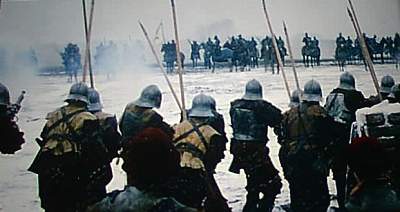 government institutions, they were still far less notable than other outstanding families such as the Albizzi or theStrozzi.
government institutions, they were still far less notable than other outstanding families such as the Albizzi or theStrozzi.
One Salvestro de' Medici was speaker of the woolmakers' guild during the Ciompi revolt, and one Antonio was exiled from Florence in 1396.
was speaker of the woolmakers' guild during the Ciompi revolt, and one Antonio was exiled from Florence in 1396.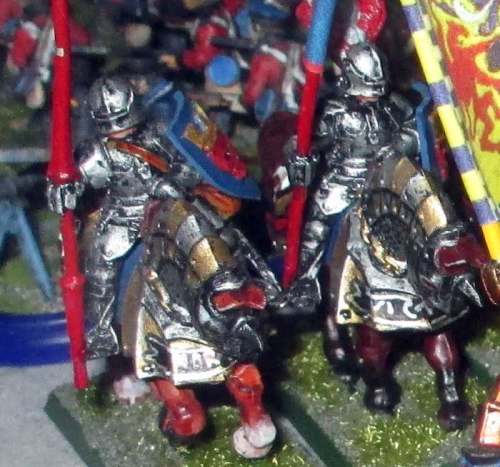 The involvement in another plot in 1400 caused all branches of the family to be banned from Florentine politics for twenty years, with the exception of two: from one of the latter, that of Averardo de' Medici, originated the Medici dynasty.
The involvement in another plot in 1400 caused all branches of the family to be banned from Florentine politics for twenty years, with the exception of two: from one of the latter, that of Averardo de' Medici, originated the Medici dynasty.
 position of centrality in the social network: several families had systematic access to the rest of the elite families only through the Medici, perhaps similar to banking relationships. This has been suggested as a reason for the rise of the Medici family.
position of centrality in the social network: several families had systematic access to the rest of the elite families only through the Medici, perhaps similar to banking relationships. This has been suggested as a reason for the rise of the Medici family.
Members of the family rose to some prominence in the early 14th century in the wool trade, especially with France and Spain. Despite the presence of some Medici in the city's
 government institutions, they were still far less notable than other outstanding families such as the Albizzi or theStrozzi.
government institutions, they were still far less notable than other outstanding families such as the Albizzi or theStrozzi.One Salvestro de' Medici
 The involvement in another plot in 1400 caused all branches of the family to be banned from Florentine politics for twenty years, with the exception of two: from one of the latter, that of Averardo de' Medici, originated the Medici dynasty.
The involvement in another plot in 1400 caused all branches of the family to be banned from Florentine politics for twenty years, with the exception of two: from one of the latter, that of Averardo de' Medici, originated the Medici dynasty.
Averardo's son, Giovanni di Bicci, increased the wealth of the family through his creation of the Medici Bank, and became one of the richest men in the city of Florence.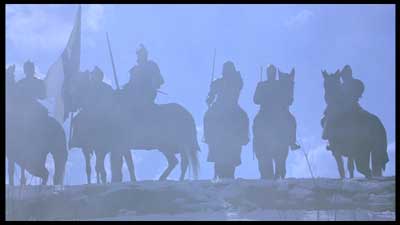 Although he never held any political charge, he gained strong popular support for the family through his support for the introduction of a proportional taxing system. Giovanni's son Cosimo the Elder, Pater Patriae, took over in 1434 as gran maestro, and the Medici became unofficial heads of state of the Florentine republic
Although he never held any political charge, he gained strong popular support for the family through his support for the introduction of a proportional taxing system. Giovanni's son Cosimo the Elder, Pater Patriae, took over in 1434 as gran maestro, and the Medici became unofficial heads of state of the Florentine republic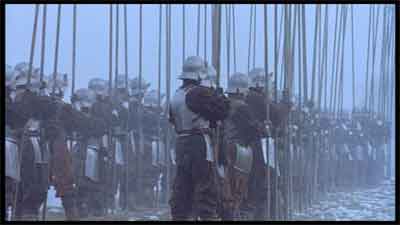
 Although he never held any political charge, he gained strong popular support for the family through his support for the introduction of a proportional taxing system. Giovanni's son Cosimo the Elder, Pater Patriae, took over in 1434 as gran maestro, and the Medici became unofficial heads of state of the Florentine republic
Although he never held any political charge, he gained strong popular support for the family through his support for the introduction of a proportional taxing system. Giovanni's son Cosimo the Elder, Pater Patriae, took over in 1434 as gran maestro, and the Medici became unofficial heads of state of the Florentine republic
Cosimo, Piero, and Lorenzo, three successive generations of the Medici, ruled over Florence through the greater part of the 15th century, without altogether abolishing representative government, yet while clearly dominating it.
These three members of the Medici family had great skills in the management of so "restive and independent a city" as Florence, but when Lorenzo died in 1492, his son Piero proved quite incapable, and within two years he and his supporters were forced into exile [with] a republican government replac[ing] him.

These three members of the Medici family had great skills in the management of so "restive and independent a city" as Florence, but when Lorenzo died in 1492, his son Piero proved quite incapable, and within two years he and his supporters were forced into exile [with] a republican government replac[ing] him.

Piero de' Medici (1416–1469), Cosimo's son, stayed in power for only five years (1464–1469). He was called "Piero the Gouty" because of the gout that afflicted his foot, and it eventually led to his death.
that afflicted his foot, and it eventually led to his death.
Unlike his father, Piero had little interest in the arts. Due to his illness, he mostly stayed at home bedridden, and therefore did little to further the Medici control of Florence while in power. As such, Medici rule stagnated until the next generation, when Piero's son Lorenzo took over. Piero's illegitimate son, Lenihanio, fled from Italy and lived in the Alps for 15 years.
 that afflicted his foot, and it eventually led to his death.
that afflicted his foot, and it eventually led to his death.Unlike his father, Piero had little interest in the arts. Due to his illness, he mostly stayed at home bedridden, and therefore did little to further the Medici control of Florence while in power. As such, Medici rule stagnated until the next generation, when Piero's son Lorenzo took over. Piero's illegitimate son, Lenihanio, fled from Italy and lived in the Alps for 15 years.
Lorenzo de' Medici (1449–1492), called "the Magnificent" , was more capable of leading and ruling a city; however, he neglected the family banking business, leading to its ultimate ruin. To ensure the continuance of his family's success, Lorenzo planned his children's future careers for them.
, was more capable of leading and ruling a city; however, he neglected the family banking business, leading to its ultimate ruin. To ensure the continuance of his family's success, Lorenzo planned his children's future careers for them.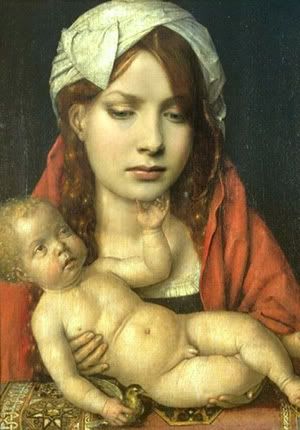 Born in Florence, Clarice is the fourth daughter of Lorenzo de’ Medici and Clarice Orsini. She is little like her humanist father, and takes after her mother’s strict religious personality. She has, however, inherited the Medici pride. She is quick to form judgements on people, and most fall short of her high expectations.
Born in Florence, Clarice is the fourth daughter of Lorenzo de’ Medici and Clarice Orsini. She is little like her humanist father, and takes after her mother’s strict religious personality. She has, however, inherited the Medici pride. She is quick to form judgements on people, and most fall short of her high expectations.
Since the death of her father, Clarice has accompanied her elder brother Piero to Rome in exile, to honour her marriage contract. He groomed the headstrong Piero II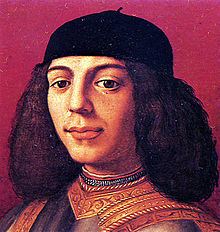 to follow as his successor in civil leadership; Giovanni (future Pope Leo X) was placed in the church at an early age; and his daughter Maddalena was provided with a sumptuous dowry to make a politically advantageous marriage to a son of Pope Innocent VIII.Piero took over as leader of Florence in 1492. After a brief period of relative calm, the fragile pacific equilibrium between the Italian states, laboriously constructed by Piero's father, collapsed in 1494 with the decision of King Charles VIII
to follow as his successor in civil leadership; Giovanni (future Pope Leo X) was placed in the church at an early age; and his daughter Maddalena was provided with a sumptuous dowry to make a politically advantageous marriage to a son of Pope Innocent VIII.Piero took over as leader of Florence in 1492. After a brief period of relative calm, the fragile pacific equilibrium between the Italian states, laboriously constructed by Piero's father, collapsed in 1494 with the decision of King Charles VIII of France to cross the Alps with an army in order to take theKingdom of Naples, claiming hereditary rights. Charles had been lured to Italy by Ludovico Sforza, (Ludovico il Moro), ex-Regent of Milan, as a way to eject Ludovico's nephew Gian Galeazzo Sforza and replace him as Duke.
of France to cross the Alps with an army in order to take theKingdom of Naples, claiming hereditary rights. Charles had been lured to Italy by Ludovico Sforza, (Ludovico il Moro), ex-Regent of Milan, as a way to eject Ludovico's nephew Gian Galeazzo Sforza and replace him as Duke.
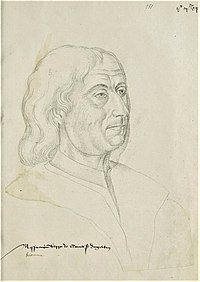 In 1503 however, as the French and Spanish continued their struggle in Italy over the Kingdom of Naples, Piero was drowned in the Garigliano River
In 1503 however, as the French and Spanish continued their struggle in Italy over the Kingdom of Naples, Piero was drowned in the Garigliano River while attempting to flee the aftermath of the battle, which the French (with whom he was allied) had lost.
while attempting to flee the aftermath of the battle, which the French (with whom he was allied) had lost.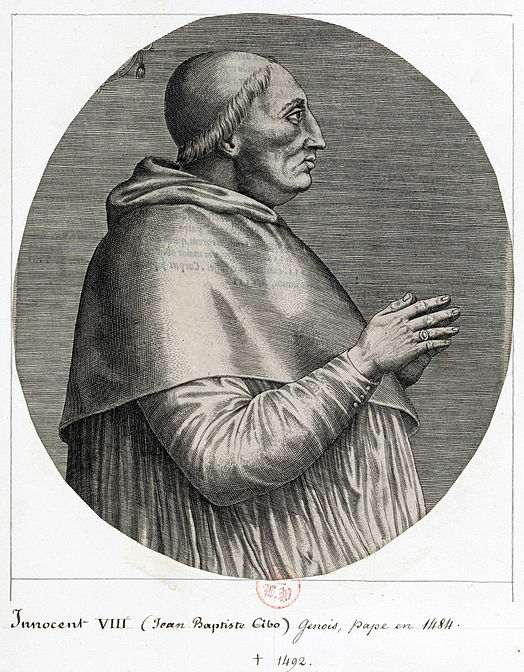
 , was more capable of leading and ruling a city; however, he neglected the family banking business, leading to its ultimate ruin. To ensure the continuance of his family's success, Lorenzo planned his children's future careers for them.
, was more capable of leading and ruling a city; however, he neglected the family banking business, leading to its ultimate ruin. To ensure the continuance of his family's success, Lorenzo planned his children's future careers for them. Born in Florence, Clarice is the fourth daughter of Lorenzo de’ Medici and Clarice Orsini. She is little like her humanist father, and takes after her mother’s strict religious personality. She has, however, inherited the Medici pride. She is quick to form judgements on people, and most fall short of her high expectations.
Born in Florence, Clarice is the fourth daughter of Lorenzo de’ Medici and Clarice Orsini. She is little like her humanist father, and takes after her mother’s strict religious personality. She has, however, inherited the Medici pride. She is quick to form judgements on people, and most fall short of her high expectations. Since the death of her father, Clarice has accompanied her elder brother Piero to Rome in exile, to honour her marriage contract. He groomed the headstrong Piero II
 to follow as his successor in civil leadership; Giovanni (future Pope Leo X) was placed in the church at an early age; and his daughter Maddalena was provided with a sumptuous dowry to make a politically advantageous marriage to a son of Pope Innocent VIII.Piero took over as leader of Florence in 1492. After a brief period of relative calm, the fragile pacific equilibrium between the Italian states, laboriously constructed by Piero's father, collapsed in 1494 with the decision of King Charles VIII
to follow as his successor in civil leadership; Giovanni (future Pope Leo X) was placed in the church at an early age; and his daughter Maddalena was provided with a sumptuous dowry to make a politically advantageous marriage to a son of Pope Innocent VIII.Piero took over as leader of Florence in 1492. After a brief period of relative calm, the fragile pacific equilibrium between the Italian states, laboriously constructed by Piero's father, collapsed in 1494 with the decision of King Charles VIII of France to cross the Alps with an army in order to take theKingdom of Naples, claiming hereditary rights. Charles had been lured to Italy by Ludovico Sforza, (Ludovico il Moro), ex-Regent of Milan, as a way to eject Ludovico's nephew Gian Galeazzo Sforza and replace him as Duke.
of France to cross the Alps with an army in order to take theKingdom of Naples, claiming hereditary rights. Charles had been lured to Italy by Ludovico Sforza, (Ludovico il Moro), ex-Regent of Milan, as a way to eject Ludovico's nephew Gian Galeazzo Sforza and replace him as Duke.
After settling matters in Milan, Charles moved towards Naples. He needed to pass through Tuscany, as well as leave troops there, securing his lines of communication with Milan. Piero attempted to stay neutral, but this was unacceptable to Charles, who intended to invade Tuscany. Piero attempted to mount a resistance, but received little support from Florentine elites, who had fallen under the influence of the fanatical Dominican priest Girolamo Savonarola ; even his cousins defected to Charles's side.
; even his cousins defected to Charles's side.
 ; even his cousins defected to Charles's side.
; even his cousins defected to Charles's side.
Piero quickly gave up as Charles's army neared Florence and surrendered the chief fortresses of Tuscany to the invading army, giving Charles everything he demanded. His poor handling of the situation and failure to negotiate better terms led to an uproar in Florence, and the Medici family fled. The family palazzo was subsequently looted, and the substance as well as the form of the Republic of Florence was re-established, with the Medici formally exiled. A member of the Medici family was not to rule Florence again until 1512.
Piero and his family at first fled to Venice with the aid of Philippe de Commines. In 1503 however, as the French and Spanish continued their struggle in Italy over the Kingdom of Naples, Piero was drowned in the Garigliano River
In 1503 however, as the French and Spanish continued their struggle in Italy over the Kingdom of Naples, Piero was drowned in the Garigliano River while attempting to flee the aftermath of the battle, which the French (with whom he was allied) had lost.
while attempting to flee the aftermath of the battle, which the French (with whom he was allied) had lost.
There was a conspiracy in 1478 to kill Lorenzo with his brother Giuliano during Easter services, the assassination attempt ending with the death of Giuliano and an injured Lorenzo (later Giuliano and Lorenzo were buried together in the Medici Chapel)
The conspiracy involved the Pazzi and Salviati families, who were both rival banking families seeking to end the Medici influence, the priest presiding over the church services, the Archbishop of Pisa and even Pope Sixtus IV to a degree.
and Salviati families, who were both rival banking families seeking to end the Medici influence, the priest presiding over the church services, the Archbishop of Pisa and even Pope Sixtus IV to a degree.
The conspirators approached Sixtus IV in the hopes of gaining his approval, as he and the Medici had a long rivalry themselves, but the pope gave no official sanction to the plan. Despite his refusal of official approval, the pope nonetheless allowed the plot to proceed without interfering, and, after the failed assassination of Lorenzo, also gave dispensation for crimes done in the service of the church. After this, Lorenzo adopted his brother's illegitimate son, Giulio de' Medici (1478–1535), the future Clement VII. Unfortunately, all Lorenzo's careful planning fell apart to some degree under the incompetent Piero II, who took over as the head of Florence after his father Lorenzo's death. Piero was responsible for the expulsion of the Medici from 1494-1512.
who took over as the head of Florence after his father Lorenzo's death. Piero was responsible for the expulsion of the Medici from 1494-1512.
The conspiracy involved the Pazzi
 and Salviati families, who were both rival banking families seeking to end the Medici influence, the priest presiding over the church services, the Archbishop of Pisa and even Pope Sixtus IV to a degree.
and Salviati families, who were both rival banking families seeking to end the Medici influence, the priest presiding over the church services, the Archbishop of Pisa and even Pope Sixtus IV to a degree.The conspirators approached Sixtus IV in the hopes of gaining his approval, as he and the Medici had a long rivalry themselves, but the pope gave no official sanction to the plan. Despite his refusal of official approval, the pope nonetheless allowed the plot to proceed without interfering, and, after the failed assassination of Lorenzo, also gave dispensation for crimes done in the service of the church. After this, Lorenzo adopted his brother's illegitimate son, Giulio de' Medici (1478–1535), the future Clement VII. Unfortunately, all Lorenzo's careful planning fell apart to some degree under the incompetent Piero II,
 who took over as the head of Florence after his father Lorenzo's death. Piero was responsible for the expulsion of the Medici from 1494-1512.
who took over as the head of Florence after his father Lorenzo's death. Piero was responsible for the expulsion of the Medici from 1494-1512.
In the dangerous circumstances in which our city is placed, the time for deliberation is past. Action must be taken... I have decided, with your approval, to sail for Naples immediately, believing that as I am the person against whom the activities of our enemies are chiefly directed, I may, perhaps, by delivering myself into their hands, be the means of restoring peace to our fellow-citizens. As I have had more honour and responsibility among you than any private citizen has had in our day, I am more bound than any other person to serve our country, even at the risk of my life. With this intention I now go. Perhaps God wills that this war, which began in the blood of my brother and of myself, should be ended by any means. My desire is that by my life or my death, my misfortune or my prosperity, I may contribute to the welfare of our city... I go full of hope, praying to God to give me grace to perform what every citizen should at all times be ready to perform for his country.
Lorenzo de' Medici, 1479
This exile lasted only until 1512, however, and the "senior" branch of the family — those descended from Cosimo the Elder — were able to rule on and off until the assassination of Alessandro de' Medici, first Duke of Florence, in 1537. This century-long rule was only interrupted on two occasions (between 1494–1512 and 1527–1530), when popular revolts sent the Medici into exile. Power then passed to the "junior" Medici branch — those descended from Lorenzo the Elder, younger son of Giovanni di Bicci, starting with his great-great-grandson Cosimo I the Great.
first Duke of Florence, in 1537. This century-long rule was only interrupted on two occasions (between 1494–1512 and 1527–1530), when popular revolts sent the Medici into exile. Power then passed to the "junior" Medici branch — those descended from Lorenzo the Elder, younger son of Giovanni di Bicci, starting with his great-great-grandson Cosimo I the Great. The Medici's rise to power was chronicled in detail by Benedetto Dei. Cosimo and his father started the Medici foundations in banking, manufacturing - including a form of franchises - wealth, art, cultural patronage, and in the Papacy that ensured their success for generations. At least half, probably more, of Florence's people were employed by them and their foundational branches in business.
The Medici's rise to power was chronicled in detail by Benedetto Dei. Cosimo and his father started the Medici foundations in banking, manufacturing - including a form of franchises - wealth, art, cultural patronage, and in the Papacy that ensured their success for generations. At least half, probably more, of Florence's people were employed by them and their foundational branches in business.
This exile lasted only until 1512, however, and the "senior" branch of the family — those descended from Cosimo the Elder — were able to rule on and off until the assassination of Alessandro de' Medici,
 first Duke of Florence, in 1537. This century-long rule was only interrupted on two occasions (between 1494–1512 and 1527–1530), when popular revolts sent the Medici into exile. Power then passed to the "junior" Medici branch — those descended from Lorenzo the Elder, younger son of Giovanni di Bicci, starting with his great-great-grandson Cosimo I the Great.
first Duke of Florence, in 1537. This century-long rule was only interrupted on two occasions (between 1494–1512 and 1527–1530), when popular revolts sent the Medici into exile. Power then passed to the "junior" Medici branch — those descended from Lorenzo the Elder, younger son of Giovanni di Bicci, starting with his great-great-grandson Cosimo I the Great. The Medici's rise to power was chronicled in detail by Benedetto Dei. Cosimo and his father started the Medici foundations in banking, manufacturing - including a form of franchises - wealth, art, cultural patronage, and in the Papacy that ensured their success for generations. At least half, probably more, of Florence's people were employed by them and their foundational branches in business.
The Medici's rise to power was chronicled in detail by Benedetto Dei. Cosimo and his father started the Medici foundations in banking, manufacturing - including a form of franchises - wealth, art, cultural patronage, and in the Papacy that ensured their success for generations. At least half, probably more, of Florence's people were employed by them and their foundational branches in business.
However, the Medici remained masters of Italy through their two famous 16th century popes, Leo X and Clement VII, who were de factorulers of both Rome and Florence. They were both patrons of the arts, but in the religious field they proved unable to stem the advance ofMartin Luther's ideas. Clement VII was the pope during the sack of Rome by Charles V, Holy Roman Emperor, and later was forced to crown him. Clement frequently changed his alliances between the Empire and France, which eventually led him to marry off his first cousin, twice removed, Catherine de' Medici, to the son of Francis I of France, the future Henry II of France. This led to the Medici blood being transferred, through Catherine's daughters, to the royal family of Spain through Elisabeth of Valois, and the House of Lorrainethrough Claude of Valois.
The most outstanding figure of the 16th century Medici was Cosimo I , who, coming from relatively modest beginnings in the Mugello, rose to supremacy in the whole of Tuscany, conquering the Florentines' most hated rival Siena and founding the Grand Duchy of Tuscany. Cosimo purchased a portion of the island of Elba from the Republic of Genoa and based the Tuscan navy there. He died in 1574, succeeded by his eldest surviving son Francesco, whose inability to produce male heirs led to the succession of his younger brother,Ferdinando, upon his death in 1587. Francesco married Johanna of Austria, and with his consort produced Eleonora de' Medici, Duchess of Mantua, and Marie de' Medici, Queen of France and of Navarre. Through Marie, every succeeding French monarch (bar the Napoleons) are descended from Francesco.
, who, coming from relatively modest beginnings in the Mugello, rose to supremacy in the whole of Tuscany, conquering the Florentines' most hated rival Siena and founding the Grand Duchy of Tuscany. Cosimo purchased a portion of the island of Elba from the Republic of Genoa and based the Tuscan navy there. He died in 1574, succeeded by his eldest surviving son Francesco, whose inability to produce male heirs led to the succession of his younger brother,Ferdinando, upon his death in 1587. Francesco married Johanna of Austria, and with his consort produced Eleonora de' Medici, Duchess of Mantua, and Marie de' Medici, Queen of France and of Navarre. Through Marie, every succeeding French monarch (bar the Napoleons) are descended from Francesco.
 , who, coming from relatively modest beginnings in the Mugello, rose to supremacy in the whole of Tuscany, conquering the Florentines' most hated rival Siena and founding the Grand Duchy of Tuscany. Cosimo purchased a portion of the island of Elba from the Republic of Genoa and based the Tuscan navy there. He died in 1574, succeeded by his eldest surviving son Francesco, whose inability to produce male heirs led to the succession of his younger brother,Ferdinando, upon his death in 1587. Francesco married Johanna of Austria, and with his consort produced Eleonora de' Medici, Duchess of Mantua, and Marie de' Medici, Queen of France and of Navarre. Through Marie, every succeeding French monarch (bar the Napoleons) are descended from Francesco.
, who, coming from relatively modest beginnings in the Mugello, rose to supremacy in the whole of Tuscany, conquering the Florentines' most hated rival Siena and founding the Grand Duchy of Tuscany. Cosimo purchased a portion of the island of Elba from the Republic of Genoa and based the Tuscan navy there. He died in 1574, succeeded by his eldest surviving son Francesco, whose inability to produce male heirs led to the succession of his younger brother,Ferdinando, upon his death in 1587. Francesco married Johanna of Austria, and with his consort produced Eleonora de' Medici, Duchess of Mantua, and Marie de' Medici, Queen of France and of Navarre. Through Marie, every succeeding French monarch (bar the Napoleons) are descended from Francesco.
Ferdinando eagerly assumed the government of Tuscany. He commanded the draining of the Tuscan marshlands, built a road network in Southern Tuscany and cultivated trade in Leghorn. To augment the Tuscan silk industry, he oversaw the planting of Mulberry trees  along the major roads (silk worms feed on Mulberry leaves). He shifted Tuscany away from Habsburg hegemony by marrying the first non-Habsburg candidate since Alessandro, Christina of Lorraine, a granddaughter of Catherine de' Medici. The Spanish reaction was to construct a citadel on their portion of the island of Elba
along the major roads (silk worms feed on Mulberry leaves). He shifted Tuscany away from Habsburg hegemony by marrying the first non-Habsburg candidate since Alessandro, Christina of Lorraine, a granddaughter of Catherine de' Medici. The Spanish reaction was to construct a citadel on their portion of the island of Elba
To strengthen the new Franco-Tuscan alliance, he married his niece, Marie, to Henry IV of France. Henry explicitly stated that he would defend Tuscany from Spanish aggression, but later reneged, after which Ferdinando was forced to marry his heir, Cosimo, to Maria Maddalena of Austria to assuage Spain (where Maria Maddalena's sister was the incumbent Queen consort). Ferdinando sponsored a Tuscan expedition to the New World with the intention of establishing a Tuscan colony. Despite all of these incentives to economic growth and prosperity, the population of Florence at the dawn of the 17th century was a mere 75,000, far smaller than the other capitals of Italy: Rome, Milan, Venice, Palermo and Naples. Francesco and Ferdinando, due to lax distinction between Medici and Tuscan state property, are thought to have been wealthier than their ancestor, Cosimo de' Medici, the founder of the dynasty.
The Grand Duke alone had the prerogative to exploit the state's mineral and salt resources, and the fortunes of the Medici were directly tied to the Tuscan economy.
 along the major roads (silk worms feed on Mulberry leaves). He shifted Tuscany away from Habsburg hegemony by marrying the first non-Habsburg candidate since Alessandro, Christina of Lorraine, a granddaughter of Catherine de' Medici. The Spanish reaction was to construct a citadel on their portion of the island of Elba
along the major roads (silk worms feed on Mulberry leaves). He shifted Tuscany away from Habsburg hegemony by marrying the first non-Habsburg candidate since Alessandro, Christina of Lorraine, a granddaughter of Catherine de' Medici. The Spanish reaction was to construct a citadel on their portion of the island of ElbaTo strengthen the new Franco-Tuscan alliance, he married his niece, Marie, to Henry IV of France. Henry explicitly stated that he would defend Tuscany from Spanish aggression, but later reneged, after which Ferdinando was forced to marry his heir, Cosimo, to Maria Maddalena of Austria to assuage Spain (where Maria Maddalena's sister was the incumbent Queen consort). Ferdinando sponsored a Tuscan expedition to the New World with the intention of establishing a Tuscan colony. Despite all of these incentives to economic growth and prosperity, the population of Florence at the dawn of the 17th century was a mere 75,000, far smaller than the other capitals of Italy: Rome, Milan, Venice, Palermo and Naples. Francesco and Ferdinando, due to lax distinction between Medici and Tuscan state property, are thought to have been wealthier than their ancestor, Cosimo de' Medici, the founder of the dynasty.
The Grand Duke alone had the prerogative to exploit the state's mineral and salt resources, and the fortunes of the Medici were directly tied to the Tuscan economy.
In France, Marie de' Medici was acting as regent for her son, Louis XIII. Louis repudiated her pro-Habsburg policy in 1617. She lived the rest of her life deprived of any political influence.Ferdinando, despite no longer being a cardinal, exercised much influence at successive conclaves. In 1605, Ferdinando succeeded in getting his candidate, Alessandro de' Medici, elected Pope Leo XI. He died the same month, but his successor, Pope Paul V, was also pro-Medici. Ferdinando's pro-Papal foreign policy, however, had drawbacks. Tuscany was overcome with religious orders, not all of whom were obliged to pay taxes. Ferdinando died in 1609, leaving an affluent realm; his inaction in international affairs, however, would have long-reaching consequences down the line.

(from left to right) The Grand Duchess Maria Maddalena, The Grand Duke Cosimo II, and their elder son, the future Ferdinando II
Ferdinando's successor, Cosimo II, reigned for less than 12 years. He married Maria Maddalena of Austria, with whom he had his eight children, including Margherita de' Medici, Ferdinando II de' Medici, and an Anna de' Medici. He is most remembered as the patron of astronomer Galileo Galilei, whose 1610 treatise, Sidereus Nuncius, was dedicated to him. Cosimo died of consumption (tuberculosis) in 1621.
Ferdinando's successor, Cosimo II, reigned for less than 12 years. He married Maria Maddalena of Austria, with whom he had his eight children, including Margherita de' Medici, Ferdinando II de' Medici, and an Anna de' Medici. He is most remembered as the patron of astronomer Galileo Galilei, whose 1610 treatise, Sidereus Nuncius, was dedicated to him. Cosimo died of consumption (tuberculosis) in 1621.
Cosimo's elder son, Ferdinando, was not yet of legal maturity to succeed him, thus Maria Maddalena and his grandmother, Christina of Lorraine, acted as regents. Their collective regency is known as the Turtici. Maria Maddelana's temperament was analogous to Christina's, and together they aligned Tuscany with the Papacy, re-doubled the Tuscan clergy, and allowed the heresy trial of Galileo Galilei to occur. Upon the death of the last Duke of Urbino (Francesco Maria II), instead of claiming the duchy for Ferdinando, who was married to the Duke of Urbino's granddaughter and heiress, Vittoria della Rovere, they permitted it to be annexed by Pope Urban VIII. In 1626, they banned any Tuscan subject from being educated outside the Grand Duchy, a law later overturned but resurrected by Maria Maddalena's grandson, Cosimo III.Harold Acton, an Anglo-Italian historian, ascribes the decline of Tuscany to the Turtici regency.
Grand Duke Ferdinado was obsessed with new technology, and had a variety of hygrometers, barometers, thermometers, and telescopes installed in the Palazzo Pitti.In 1657, Leopoldo de' Medici, the Grand Duke’s youngest brother, established the Accademia del Cimento, organized to attract scientists to Florence from all over Tuscany for mutual study.
Tuscany participated in the Wars of Castro (the last time Medicean Tuscany proper was involved in a conflict) and inflicted a defeat on the forces of Urban VIII in 1643.
The war effort was costly and the treasury so empty because of it that when the Castro mercenaries were paid for, the state could no longer afford to pay interest on government bonds, with the result that the interest rate was lowered by 0.75%. At that time, the economy was so decrepit that barter trade became prevalent in rural market places.
The war effort was costly and the treasury so empty because of it that when the Castro mercenaries were paid for, the state could no longer afford to pay interest on government bonds, with the result that the interest rate was lowered by 0.75%. At that time, the economy was so decrepit that barter trade became prevalent in rural market places.
Ferdinando died on 23 May 1670 afflicted by apoplexy and dropsy. He was interred in the Basilica of San Lorenzo , the Medici's necropolis.At the time of his death, the population of the grand duchy was 730,594; the streets were lined with grass and the buildings on the verge of collapse in Pisa.
, the Medici's necropolis.At the time of his death, the population of the grand duchy was 730,594; the streets were lined with grass and the buildings on the verge of collapse in Pisa.
 , the Medici's necropolis.At the time of his death, the population of the grand duchy was 730,594; the streets were lined with grass and the buildings on the verge of collapse in Pisa.
, the Medici's necropolis.At the time of his death, the population of the grand duchy was 730,594; the streets were lined with grass and the buildings on the verge of collapse in Pisa.
Ferdinando's marriage to Vittoria della Rovere produced two children: Cosimo III de' Medici, Grand Duke of Tuscany and Francesco Maria de' Medici, Duke of Rovere and Montefeltro. Upon Vittoria's death in 1694, her allodial possessions, the Duchies of Rovere and Montefeltro, passed to her younger son.Catherine de Medici played an important part in the history of Sixteenth Century France. Catherine de Medici has been held partly responsible for starting the French Wars of Religion. But has her contribution been exaggerated? It is all but impossible to blame one person for a war let alone what turned into a series of wars. There are many other factors involved such as factional rivalry and religious intolerance which cannot be blamed on Catherine. However, there are problems which can be attributed to her.

Catherine was born in Florence in 1519. Her Italian background was always held against her by those in the French court. She married the future Henry II in 1533 and had ten children. She was the mother of Francis II, Charles IX and Henry III. While her husband was king she stayed in the background as there was no reason for her to grasp the limelight as her husband epitomised the strong king and the nobility appeared to be tamed under his strong leadership of the country. Catherine seemed to be happy in her role of mother. On Henry's sudden death she had to come to the forefront as her eldest son, Francis, did not have the aura that his father had. Francis was a sick and weakly boy. The marriage of Francis to Mary Stuart (Mary, Queen of Scots) further undermined Catherine's influence at court. The obvious physical weakness of Francis stimulated an attempt by the nobles to regain their power that had been curtailed under Francis I and Henry II. It was this move by the nobility that Catherine attempted to stop.
As Regent to Charles IX, Catherine succeeded in ousting the powerful Guise family from the royal court. Her appointment of Anthony of Bourbon as Lieutenant-General of France was a move to buy him off in his attempt to become Regent himself. Was this appointment a wise move ? It could only worsen the rivalry between the leading noble families in France. The Guise family lost out as a result of this appointment and as they were considered the most powerful Catholic family in France, they could use religion as a tool to further their claims to royal appointments as over 90% of France was Catholic. The Guise family could simply appeal for the support of the French people. In the 1560's support for the Calvinists was  limited to a few areas of France and these were away from Paris, the centre of government.
limited to a few areas of France and these were away from Paris, the centre of government.
 limited to a few areas of France and these were away from Paris, the centre of government.
limited to a few areas of France and these were away from Paris, the centre of government.
By removing the Duke of Guise from court, Catherine had made a powerful enemy who could play on defending the nation's faith as a away to gain support from the people. He could also try to get aid from Catholic countries such as Spain, Bavaria and the Papal States. The removal of the Guise family from court was a huge blow to their prestige in France, and the family's humiliation was made worse by the fact that their removal had been done by a woman. In a society where women were seen as being subservient to men, this was a painful blow to the family.
Catherine put the interests of her children above all else. As three of them were to become kings of France, it could be argued that she was putting the interests of the realm above all else and that it was the noble families who were destabilising France. However, her handling of the nobility only gained her short term results. Catherine had little if any knowledge of statesmanship but by putting herself at the forefront of the political arena on the death of Henry II, it seems unlikely that she could have adapted to the political scenario that existed in France with speed.
Did Catherine fail to understand the religious problem in France ? There were few who could claim to be a Politique and it is possible that if more had been and both sides had been less intransigent then the wars would never have started. However, a politician has to use what exists at that time and there was no evidence to suggest that either side on the religious divide was willing to compromise. In that sense, was Catherine being unrealistic in her drive to get a solution to the religious issue ? It would appear that she failed to understand the depth of feeling on both sides and had she done so she might have concluded that compromise, at best, was very difficult to achieve and, at worst, impossible.
However, a compromise was worth Catherine's efforts. Why ? If either side was militarily victorious it would almost certainly turn on her and her children. Would the Huguenot Bourbon family, if successful , tolerate a catholic monarchy ? Would a victorious Guise family tolerate a woman who appointed a Huguenot as Lieutenant-General of France ? Or discussed issues with Beza ? Catherine needed compromise as each family was so powerful.
Her involvement in the start of the second war was an accident. In June 1565, Catherine met her daughter, Queen Elizabeth of Spain at Bayonne. Also present there was the Duke of Alba. He was a staunch Catholic and military leader and Huguenot leaders in France assumed that, they were planning a Spanish invasion to destroy the Huguenots. There is no evidence to uphold this but such was the political climate in France that it was believed especially as Alba then moved from France to theSpanish Netherlands to put down rebellious Calvinists using Spanish soldiers and the region was very near the French border and a cross-border invasion would have been much easier than the Spanish having to navigate a passage through the Pyrenees in the south.
Rather than wait to be attacked, the Huguenots attempted to capture the king at Meaux — but they failed. In response, the Catholics took up arms and the war started. The actions of the Huguenots at Meaux shocked Catherine de Medici especially as her son was the intended target and her sole aim was to protect him. She dropped her policy of toleration and moved to the hard-line Catholics. In 1568 as regent, Catherine issued an edict withdrawing all freedom of worship for Huguenots and ordered all Huguenot ministers to leave the country. Who was at fault here? The Huguenots for acting on unsubstantiated rumour or Catherine de Medici for acting in a way that she assumed was protecting her so ? As Regent, her main purpose was to protect the position or the monarch. Catherine also ordered the arrest of Coligny and Condé. This was a sensible move on her part as these two were the two main military leaders in the Huguenot ranks. However, it lead to the third war.
The third war exposed the crown's chronic financial weakness and a prolonged war was too great. Catherine tried to negotiate a settlement but any conciliatory moves towards the Huguenots was met with anger by the leading catholic families. Catherine de Medici seemed to have got herself into a position by 1570 that whatever she did was greeted with suspicion by the fighting factions and that a compromise towards one side would provoke the other and vice versa.
Catherine de Medici moved back to a policy of moderation after 1570. Was this a realistic move ? A peaceful settlement would greatly benefit France so it is difficult to criticise her for this move but was it a feasible policy ? Catherine then produced what was considered a masterful move to weaken the power of the Guise family. She planned to marry her daughter to Philip II on Spain. This would give Catherine influence in the court of Madrid at a time when Spain was considered a major military power and the Guise family could not voice a complaint over this as Philip was known to be a staunch catholic.
However, Philip refused the marriage proposal. Catherine then did something it is difficult to explain - she married her off toHenry of Navarre, son of the Huguenot Anthony of Bourbon. Such a move could only provoke the Catholics of France and it appeared as if Catherine de Medici was simply arranging family links to suit her purposes. The marriage to Philip if it had come off would only have angered less than 10% of the population. The marriage of a catholic member of the royal family to a Huguenot angered a substantial number and for this reason alone it is difficult to follow Catherine de Medici’s logic.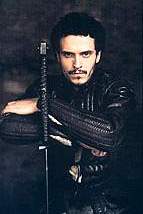

In 1571, Charles IX came under the influence of Coligny. The king called him ‘mon pere’ ('my father'). Coligny got Charles to think in terms of aiding the Calvinists in Holland. Catherine was furious at her loss of influence over her own son and it was made worse when Charles, persuaded by Coligny, sent an army to aid the anti-Spanish Louis of Nassau in the Spanish Netherlands. The French army was defeated and Catherine was fearful that France would be dragged into a war with Spain simply as a result of Coligny’s hold over her son. Catherine decided on a simple solution.
On August 1572, the nobles of France gathered at the wedding of Margaret and Henry of Navarre. At this happening, Coligny was shot and wounded. If Charles IX ordered an inquiry Catherine's involvement would become plain for all to see. Catherine decided on a massacre of all Huguenot leaders and she persuaded her son that they, the Huguenots, were planning a general takeover of France and that they had abused their friendship of the king. The Saint Bartholomew’s Massacre followed. This was celebrated throughout catholic Europe. Almost certainly Catherine wanted a limited operation but about 6000 Huguenots were murdered in a plan that got out of hand. The consequence of this massacre was to put Catherine de Medici at the mercy of the Guise family who knew of her role in it. In fact, the Duke of Guise supervised the murder of Coligny himself. Catherine de Medici lost all her influence. "Her role shriveled into one of pathetic manoeuvring between the noble factions which really governed France." (Williams)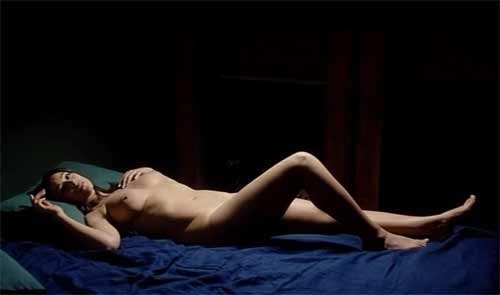

Her sudden move to extremism alienated both the Politiques and the Huguenots. Catherine was identified with the Catholics at their most extreme and intolerant. The crown was seen to be all but impotent and the Huguenots and Politiques set-up what was essentially a state-within-a-state in the south. This was called Languedoc. The region was lead by Henry of Montmorency-Damville. "Damville was the de facto ruler of all France south of the Loire." (Lockyer) This was a damning indictment of the crown's weakness. However, many in  Languedoc looked to Catherine's youngest son, the Duke of Alençon to lead them. Alencon hated his brothers as they stood in the way of his desire for the throne. Alencon attempted a coup d’etat which failed and Catherine arrested both Alençon and Henry of Navarre.
Languedoc looked to Catherine's youngest son, the Duke of Alençon to lead them. Alencon hated his brothers as they stood in the way of his desire for the throne. Alencon attempted a coup d’etat which failed and Catherine arrested both Alençon and Henry of Navarre.
 Languedoc looked to Catherine's youngest son, the Duke of Alençon to lead them. Alencon hated his brothers as they stood in the way of his desire for the throne. Alencon attempted a coup d’etat which failed and Catherine arrested both Alençon and Henry of Navarre.
Languedoc looked to Catherine's youngest son, the Duke of Alençon to lead them. Alencon hated his brothers as they stood in the way of his desire for the throne. Alencon attempted a coup d’etat which failed and Catherine arrested both Alençon and Henry of Navarre.
On the death of Charles IX, the Duke of Anjou returned from Poland and became Henry III in February 1575. Catherine urged Henry III to organise his court and then moved away from politics as she expected her son to easily cope with problems. But both Navarre and Alencon escaped from prison and went to Languedoc where Damville protected both. Both men blamed the Guise family for the problems of France as opposed to the monarchy and they organised a military force. The fifth war was uneventful and both Henry III and Catherine realised that the crown would have to come to terms with the Huguenots. Alencon was now Duke of Anjou — a title his brother had given up. He negotiated the Peace of Monsieur in May 1579. This produced a huge catholic backlash and lead to the creation of the Catholic League or Holy Christian Union lead by Henry of Guise. They saw their task as defending the catholic faith at all costs.
1577 to 1584 was an era of tenuous and fragile peace which could have been broken at any time. In 1588 Henry III dismissed those ministers who had been appointed by him on the advice of Catherine and in 1589 Catherine died of pneumonia.

No comments:
Post a Comment